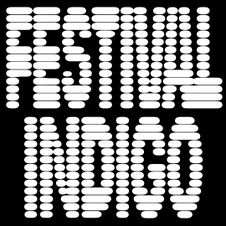Indigo Festival
Background
Since 2021, the festival has taken place at the Cukrarna Gallery, a new venue run by Museum and Galleries of Ljubljana.
At the very beginning, for a few years, the festival brought together cultural producers in the Ljubljana quarter surrounded by Križevniška Street, French Revolution Square, Gosposka Street, New Square, Breg and Salendrova Street, where important Slovene cultural institutions are located, such as the Museum and Galleries of Ljubljana, Mini Theatre, the Scientific Research Centre (ZRC SAZU), Slovene Academy of Science and Arts, Festival Ljubljana, the Secondary School for Design and Photography, Ljubljana and the National and University Library. The festival aimed to connect these cultural and scientific institutions with non-governmental organisations and creative individuals, it took place throughout the very quarter, in both the institutions and outdoors on the city streets. The programme connected the rich artistic heritage of this neighbourhood with cultural creation and theoretical reflection on contemporary society.
Programme
The first Indigo Festival took the topic "No Fear" and dealt with strategies to overcome the fear of the unknown through current changes in society. Many theorists and speakers participated in a series of discussions on design, architecture, art and ecology, such as Vuk Ćosić, Rick Poynor, Špela Hudnik and Marko Paunović, among others. In the artistic part of the festival, visitors could take in a concert by the group Bowrain; the exhibition Young Balkan Designers 2016; the poster exhibition Fist in the Eye with designers Mirko Ilić, Tomato Košir, Novi kolektivizem, Bojan Hadžihalilović, etc.; an exhibition by Bara Kolenc and Anej Tutta; and many more. The evenings were coloured by DJs, otherwise renowned Slovene sound artists and theatre and film composers, such as Drago Ivanuša, Mitja Vrhovnik Smrekar, etc.
The second edition carried the topic "Truth and Lies". By monitoring everyday events, we are subjected to media constructs that constantly operate with the concept of what is real and what is not. The plethora of news competing with each other creates a spiritual impoverishment that does not allow for a dignified perception of the space and time in which we live. Art and theory, with exceptions, are among the last havens offering reflection. Through the talks, lectures, concerts, exhibitions, performances and workshops, the second Indigo Festival showed the contemporary erasure of borders between the lie and the truth. Slovene philosopher Renata Salecl, British designer Jonathan Barnbrook, Croatian designer Lana Cavar, the founder of the Société Réaliste and designer Ferenc Gróf, Austrian philosopher Robert Phaller, the music band Papooz, Croatian songwriter Sara Renar, DJ Levanael and many more participated.
The third edition was dedicated to "Rumours", a silent force that affects public opinion and behaviour, personal decisions and relations between people and communities. During 3 festival days, 24 events took place: the festival hosted more than 120 lecturers, designers, performers, film makers, musicians and other artists from 14 countries, such as English designer James Langdon, the design group Experimental Jetset, Irish writer Angela Nagle, philosopher Mladen Dolar, Laibach group, etc. More than 3500 local and foreign visitors attended this increasingly popular festival.
The 2020 edition's topic was Now is Too Late.
See also




